

Johannes Kepler. Johannes Kepler (German: [ˈkʰɛplɐ]; December 27, 1571 – November 15, 1630) was a German mathematician, astronomer, and astrologer.

A key figure in the 17th century scientific revolution, he is best known for his laws of planetary motion, based on his works Astronomia nova, Harmonices Mundi, and Epitome of Copernican Astronomy. These works also provided one of the foundations for Isaac Newton's theory of universal gravitation. Gérard Desargues. Girard Desargues Born in Lyon, Desargues came from a family devoted to service to the French crown.
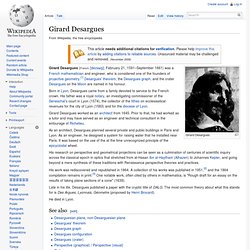
His father was a royal notary, an investigating commissioner of the Seneschal's court in Lyon (1574), the collector of the tithes on ecclesiastical revenues for the city of Lyon (1583) and for the diocese of Lyon. Girard Desargues worked as an architect from 1645. Prior to that, he had worked as a tutor and may have served as an engineer and technical consultant in the entourage of Richelieu. René Descartes. Descartes laid the foundation for 17th-century continental rationalism, later advocated by Baruch Spinoza and Gottfried Leibniz, and opposed by the empiricist school of thought consisting of Hobbes, Locke, Berkeley, and Hume.
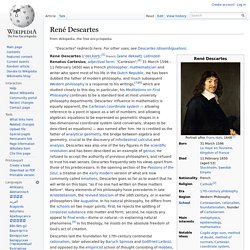
Leibniz, Spinoza and Descartes were all well versed in mathematics as well as philosophy, and Descartes and Leibniz contributed greatly to science as well. His best known philosophical statement is "Cogito ergo sum" (French: Je pense, donc je suis; I think, therefore I am), found in part IV of Discourse on the Method (1637 – written in French but with inclusion of "Cogito ergo sum") and §7 of part I of Principles of Philosophy (1644 – written in Latin). Early life[edit] Descartes was born in La Haye en Touraine (now Descartes), Indre-et-Loire, France. Bonaventura Cavalieri.
Bonaventura Francesco Cavalieri Monument to Cavalieri in Milan.
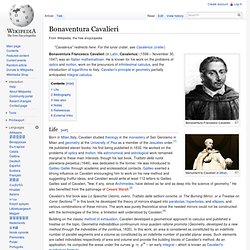
Life[edit] Cavalieri's first book was Lo Specchio Ustorio, overo, Trattato delle settioni coniche, or The Burning Mirror, or a Treatise on Conic Sections.[3] In this book he developed the theory of mirrors shaped into parabolas, hyperbolas, and ellipses, and various combinations of these mirrors. The work was purely theoretical since the needed mirrors could not be constructed with the technologies of the time, a limitation well understood by Cavalieri.[4] Building on the classic method of exhaustion, Cavalieri developed a geometrical approach to calculus and published a treatise on the topic, Geometria indivisibilibus continuorum nova quadam ratione promota (Geometry, developed by a new method through the indivisibles of the continua, 1635)
. – an early integral – which is known as Cavalieri's quadrature formula. Bibliography[edit] See also[edit] List of Roman Catholic scientist-clerics Notes[edit] Erasmus Reinhold. Erasmus Reinhold (October 22, 1511 – February 19, 1553) was a German astronomer and mathematician, considered to be the most influential astronomical pedagogue of his generation.[1] He was born and died in Saalfeld, Saxony.

He was educated, under Jacob Milich, at the University of Wittenberg, where he was first elected dean and later became rector. In 1536 he was appointed professor of higher mathematics by Philipp Melanchthon. François Viète. François Viète (Latin: Franciscus Vieta; 1540 – 23 February 1603), Seigneur de la Bigotière, was a French mathematician whose work on new algebra was an important step towards modern algebra, due to its innovative use of letters as parameters in equations.

He was a lawyer by trade, and served as a privy councillor to both Henry III and Henry IV. Thomas Digges. Thomas Digges (c.1546 – 24 August 1595) was an English mathematician and astronomer.
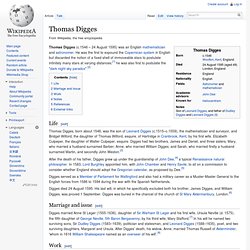
He was the first to expound the Copernican system in English but discarded the notion of a fixed shell of immoveable stars to postulate infinitely many stars at varying distances;[1] he was also first to postulate the "dark night sky paradox".[2] Giordano Bruno. Michael Servetus. Michael Servetus (Spanish: Miguel Serveto Conesa), also known as Miguel Servet, Miguel Serveto, Revés, or Michel de Villeneuve (29 September?

1509 or 1511 – 27 October 1553), was a Spanish theologian, physician, cartographer, and Renaissance humanist. He was the first European to correctly describe the function of pulmonary circulation. He was a polymath versed in many sciences: mathematics, astronomy and meteorology, geography, human anatomy, medicine and pharmacology, as well as jurisprudence, translation, poetry and the scholarly study of the Bible in its original languages. He is renowned in the history of several of these fields, particularly medicine and theology. He participated in the Protestant Reformation, and later developed a nontrinitarian Christology. Thomas Harriot. Galileo Galilei.
Galileo Galilei (Italian pronunciation: [ɡaliˈlɛːo ɡaliˈlɛi]; 15 February 1564[3] – 8 January 1642), often known mononymously as Galileo, was an Italian physicist, mathematician, engineer, astronomer, and philosopher who played a major role in the scientific revolution during the Renaissance.
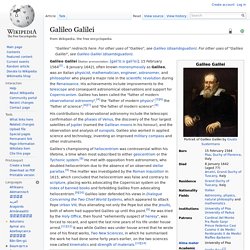
His achievements include improvements to the telescope and consequent astronomical observations and support for Copernicanism. Galileo has been called the "father of modern observational astronomy",[4] the "father of modern physics",[5][6] the "father of science",[6][7] and "the father of modern science".[8] Early life. Pierre Gassendi.